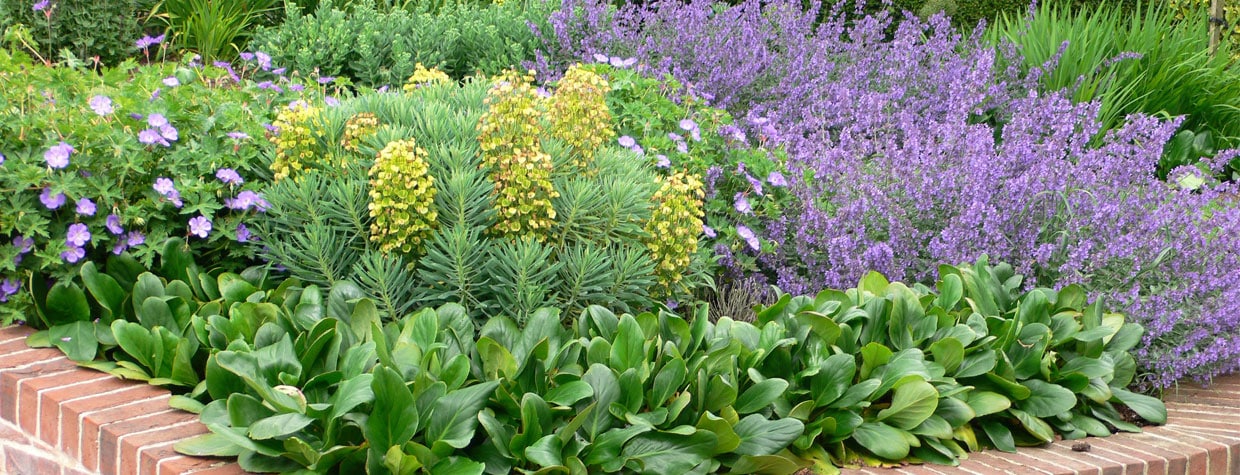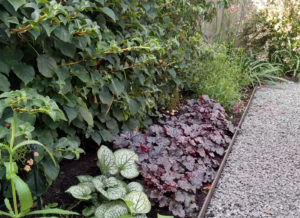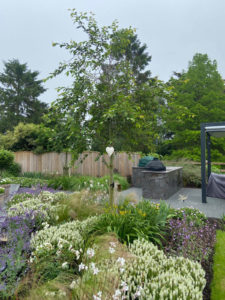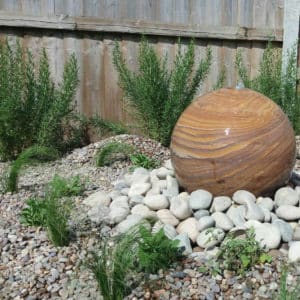10 Mar How To Design A Garden Border
Are you disappointed with your garden? Feel it’s time for a planting refresh? Here are Katie’s tips on how to design a garden border.
10 Things To Consider When You Design A Garden Border
- Size. Think in 3D – how long, wide and tall do you want your garden border to be?
- Shape. Are you wanting curves? Straight lines? Geometric shapes?
- Where will you view your garden border from? Indoors? Upstairs? Garden gate?
- Aspect. How much sunshine does the border receive throughout the day?
- Soil type. Is the soil acidic or alkaline? Well drained or soggy?
- Function. What do you want from your garden border? Screening, edibles, cut flowers, wildlife interest?
- Problems to overcome. What challenges (if any) might your border face? Slopes? Potential rabbit damage? Soggy soil? Assaults from flying footballs?
- Time of year. When do you want your borders to look their best? One particular season or all year round?
- Maintenance. How much time will you be able to spend caring for your plants and soil?
- Style. What visual effect would you like to achieve? Blowsy and flowery? Colourful? Textural? Minimalist? Contemporary?
Designing a really beautiful garden border involves a lot of thought and planning. Nipping down the the garden centre and filling your trolley with whatever appeals to you on the day will bring you about a month’s worth of pleasure. But once the plants start to settle in (or not), and the flowers and foliage changes with the seasons, any mistakes will stick out like a sore thumb. So it’s worth sitting down with a pen, a paper and a laptop to really think about what you should plant.
This narrow garden border uses layers of plants, with taller shrubs to disguise the fence and low growing ground cover plants to offer colour and texture. A border like this is easy to maintain and looks good all year round.
How To Start Designing A Garden Border
If you are not used to visualising planting schemes, the best way to start designing your garden border is to get outside and get to know the space.
Where does the sun rise and set? Are there any trees or buildings nearby that might cast a shadow? Will your border be in sun for most of the day or in shade?
What is the soil like? Is it sandy or sticky? How well does it retain water? It’s worth buying a soil testing kit from the garden centre so that you can discover the soil pH. Some plants are quite fussy about soil acidity, you need to be sure that you are choosing species that will thrive in your garden.
If you are planning a planting refresh, start by removing all of the plants you no longer want. Then reach for the secateurs and tame any overgrown shrubs that you intend to keep.
What shape do you want your new border to be? A good way to visualise it is to lay your garden hose on the ground and move it around until it marks out a shape and a size that you like. Don’t forget to look at the border shape from all angles. Including from inside the house, from the garden gate, from your usual seating area and from the bottom of the garden. When you are happy, use spray paint to mark the area clearly. Next, take photos and measurements so that you can continue the planning process indoors.
This herbaceous border has a limited colour pallet to create a soft, restful look and feel. These are bee-friendly plants which will mainly die back during the winter months. The tree is lit from below and will become a focal point in the evenings.
What Is Your Garden Border For?
It seems like an odd question but it is an important one. What are you hoping to achieve with your new garden border?
Would you like to create a scented backdrop for summer entertaining? Are you hoping to grow edibles such as herbs or soft fruit? (There’s no reason why edibles should not be planted amongst ornamentals, in fact potager type gardens have a charm all of their own.)
Do you want to screen off another part of the garden? Or hide an unfortunate view? How do you feel about attracting wildlife to your garden? Are you planning a bee friendly border?
Use a mind map or a mood board to record your thoughts.
Here’s how to create a garden design mood board
Any Problems?
Are you anticipating any problems with your garden border? Perhaps your pet dog loves to dig? Or maybe the border is in a particularly sunny spot where the soil is prone to drying out. Careful plant choices and design features can help you to overcome most issues.
Why not give your garden border a theme? Here we’ve used a gravel mulch and some smooth pebbles amongst coastal and mediterranean plants.
When Should Your Garden Border Look It’s Best?
We all enjoy our gardens in different ways. If your garden border is going to be visible from the house, you might want to make sure it has all year round interest. Perhaps add some structural plants and some lighting to make sure it looks good in winter time.
Or maybe your border is there to hide a feature such as a shed. Some of our loveliest summer flowers become dormant in the winter months, so you will need some screening plants that have great form all year round.
Creating an arbour or an outdoor seating area? Maybe you should focus on plants for spring, summer and autumn when you are most likely to be sitting outdoors. Will you need species that will provide shade or shelter from strong breezes?
Styling Your Garden Border
How would you like your border to look? Do you want a holiday look and feel – with exotic, jungle-like plants? Or will you design a garden border similar to a typical cottage garden – with lots of flowers and scents all mingling? Maybe a more minimalist style would suit your property better? Keep adding to your mood board – it may take a while but you will eventually hit on styling features that you love. Oh – and don’t forget that you can use lighting, art or a water features as a focal point.
Choose the right plants for the conditions. This living roof garden has lots of plants that particularly enjoy good drainage and plenty of sunshine. This picture was taken soom after planting. The plants will eventually all grow so that the aggregate mulch is barely visible.
Choosing Plants
Now comes the fun bit. The plants. Grab yourself some inspirational images from you mood board and start to work out which plants you’d like, how many of them you’ll need to buy and where you’ll plant them in relation to each other.
Think about the plants’ eventual size. Some of those wee plants in the garden centre may take 3-4 years to reach full size so don’t judge them by what they look like now. And don’t worry if they initially look as though you’ve planted them too far apart. You haven’t.
Planting in groups of 3 or 5 will create a much more dramatic effect.
Repeat groups of plants throughout the border – it gives continuity and is restful on the eye.
Include structural plants such as grasses or evergreens to give the border height and symmetry. If you are creating a formal border, symmetry is crucial.
Use the art of hide and reveal. Contrary to popular belief, there are no rules about having tall plants at the back of the border and shorter ones at the front. It is a good way to make sure that every plant gets seen from every angle, but there’s something rather lovely about walking along a border and realising that there’s a gorgeous plant peeping out from behind a taller one.
Use grasses within a border – they bring movement and sound. Plus you get a lovely effect when the evening sun glints through the fronds.
Most importantly of all though – design a garden border with plants that will thrive in the soil type and aspect you have planned for them. If plants are happy, they need a lot less maintenance!
Ornamental grasses are a great addition to a garden border. They offer sound and movement and keep their good looks all through the winter.
Help To Design A Garden Border
Tapestry Design Studios offer a planting design service where myself (Katie) or another member of our team will meet with you to discuss ideas and then draw up a plan. The plan will tell you which plants will work well in your garden border and suggest where to place them for optimum effect.
If you would like our help, please don’t hesitate to get in touch.
You might enjoy this article from Holland Landscapes about planting combinations.










No Comments